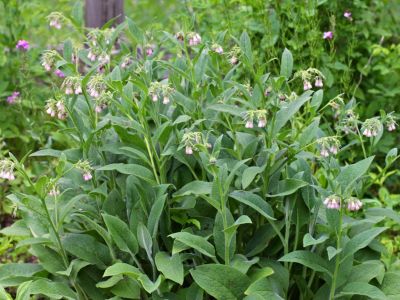What is Comfrey?
Symphytum officinale, or comfrey herb plant, has a long history of use as a medicinal herb but not as a culinary plant. Otherwise known as knitbone or slippery root, comfrey plants have been used medicinally since 400 B.C. to stop heavy bleeding and to treat bronchial issues. From the family Boraginaceae, comfrey is a perennial herb with a spreading habit that attains a height of up to 4 feet (1 m.). This plant is native to Europe and Asia where it thrives in moist, shady locations and bears ½-inch (1 cm.) long flowers in May. The leaves of the comfrey are deep green in color, hairy, and 10 inches (25 cm.) or so in length.
Growing Comfrey Plants
Growing comfrey plants requires a climate in hardiness zone USDA 3 through 9 (although some ornamental varieties are only hardy to zone 5) with rich, moist, alkaline soil (pH of 6.7-7.3). Comfrey plants generally prefer shade to part shade exposures in warm moist soil, although some cultivars require full sunlight to attain highest yields. There are some aggressive species and many self-sow readily. Propagation can be done via seed, division, or separation. Sow comfrey seeds in fall or early spring directly in the garden or in a cold frame and pot seedlings to be over-wintered inside. Division of comfrey herb plants may occur at any time, however, spring is suggested. Divide by cutting off 3 inches (8 cm.) of root below the soil level and then plant directly into a pot or another area of the garden. As comfrey can be an aggressive spreader, you may want to plant within a physical barrier and deadhead flowers to rein in its spreading habit. Comfrey plants are easy to grow and require very little maintenance once established. This perennial is generally frost and drought hardy as well as being primarily disease and pest resistant.
Comfrey Uses
As mentioned above, the comfrey herb plant has a long history of medicinal usage. Useful not only for staunching blood flow and arresting some bronchial ailments, comfrey has also been used to heal broken bones. Comfrey tea is often ingested for internal illness and poultices are applied to external ailments. Comfrey contains high amounts of allantioin (also found in nursing mother’s milk) and is said to increase the rate of cell growth, which in turn increases the number of white blood cells. The application of allantoin has been shown to heal wounds and burns more quickly and promotes healthy skin with high mucilage content. Due to this by-product of moisturizing and soothing, comfrey may be added to some cosmetics, cream, lotions, and some people even add it to their bath water. At one time, comfrey herb plant was used as a forage crop but has been found to be unpalatable to some animals and recently has also been found to be possibly carcinogenic. Today the herb is restricted as a food crop and essentially used commercially for cosmetics and ornamental uses, including its use as a dye. Comfrey fertilizer is also used for composting, mulching, or green manure. Some people eat comfrey, as it is a great source of plant-derived vitamin B12 primarily for vegetarians and vegans. Larger amounts of essential amino acids are found in turnip greens and spinach, so the jury is still out about whether the beneficial nutrition outweighs the possible harmful carcinogenic issues.
